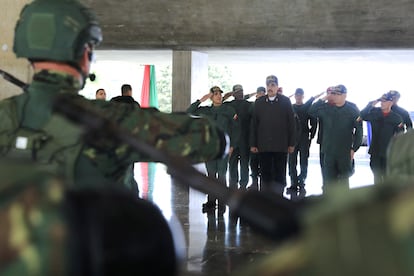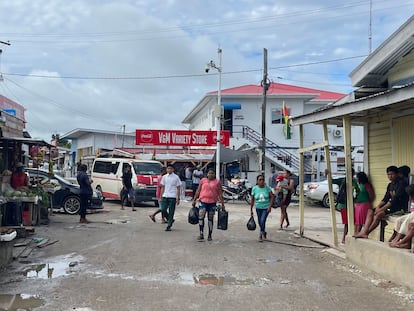Maduro orders defensive military exercises before the arrival of a British ship to the coast of Guyana
Venezuela moves troops in the area even as the neighboring country denies ‘plans for offensive action’


The president of Venezuela, Nicolás Maduro, has ordered to start “defensive actions” in the Atlantic Ocean on Thursday after the arrival of a British warship off the coast of Guyana. The vice-president of that country, Bharrat Jagdeo, has shortly after denied “plans for an offensive” against its neighbor, who claims sovereignty over the Essequibo, a jungle territory rich in minerals and oil. “These are routine measures that are planned for a long time, they are part of building defense capabilities. We do not plan to invade Venezuela, President Maduro knows that. We have no plans to take offensive action against Venezuela,” Jagdeo added.
Maduro, who spoke about the territorial conflict during his New Year’s message, has qualified the presence of the British Navy ship as a “threat [...] against peace and sovereignty”. His government also denounced it as an act of “hostile provocation” and a violation of the bilateral agreements signed in mid-December in St. Vincent and the Grenadines. A couple of weeks of apparent calm followed the meeting between Presidents Maduro and Irfaan Ali, organized by Brazil with the support of the countries of the Caribbean Community (Caricom), to defuse the escalation of tensions between Venezuela and Guyana over control of the Essequibo.
Now, the Venezuelan Foreign Ministry has said in a statement that the arrival of the military vessel HMS Trent is “extremely serious” and follows the declarations of Guyana’s allies such as the United Kingdom and the United States in the territorial dispute. “Venezuela urges the Guyanese authorities to take immediate action for the withdrawal of the vessel and to refrain from continuing to involve military powers in the territorial dispute.”
The Venezuelan Armed Forces announced the operational deployment of 5,600 soldiers on the country’s eastern coast, which includes disputed territorial waters. “We are going with the best disposition, with the best attitude of a trained combatant to guard Venezuelan territory and exercise sovereignty”, said Ashraf Suleiman Gutiérrez, head of the Strategic Region of Integral Maritime Insular Defense. The beginning of the mobilization of ocean patrol boats, ships, missile boats, F-16 and Sukhoi fighter planes, amphibious and anti-aircraft defense vehicles, among other equipment, was broadcast on television and authorized live by Maduro dressed in military attire.
In the midst of an internal whirlwind after the primaries in which the Venezuelan opposition closed ranks around candidate María Corina Machado, Maduro has dusted off a two-century-old conflict with Guyana over the sovereignty of the Essequibo, an extensive territory of 160,000 square kilometers, five times the surface of Belgium, with important mineral and oil riches. In the maps of 1777 the border of the Captaincy General of Venezuela included this area. But it was British Guyana, and later independent Guyana, which ended up occupying this territory. After the Paris Arbitral Award of 1899, a document considered rigged by Venezuela, Guyana’s border was moved westward to keep that portion within its limits. For decades, this controversy was mediated at the request of the United Nations in the framework of the Geneva Agreement of 1966 and five years ago led to the International Court of Justice, whose jurisdiction to settle this conflict is rejected by Venezuela.
One day after the opposition primaries which mobilized more than two million Venezuelans, Maduro announced a referendum for December 3 in which the annexation of the Essequibo was approved, albeit with participation levels that have been questioned, due to the low mobilization seen in the streets and the absence of disaggregated results on the votes. Alarm bells went off in Latin America and were even discussed in an informal session of the UN Security Council. In spite of this, Maduro pushed forward and appointed authorities in the region, ordered the registration of its citizens and decreed a new map of the country with the Essequibo. Guyana, which in recent years has granted oil concessions in the disputed waters, also followed suit with the hoisting of its flag in the disputed sector and the mobilization of its allies in the field of diplomacy.
This is a simmering tension that might be politically exploited by Chavismo, according to several analysts, in order to suspend the 2024 presidential elections, in which it would be at a disadvantage if it is forced to comply with the democratic guarantees demanded by the international community, under the argument that an escalation with Guyana would force it to declare a state of emergency.
After the meeting in St. Vincent and the Grenadines on December 14, the parties agreed to continue in dialogue and to avoid taking measures that could further complicate the situation. A couple of weeks later, the small Caribbean country was also the venue for the exchange of U.S. prisoners for the businessman Alex Saab, arrested for money laundering in the United States, which accuses him of being a frontman for high-ranking officials of the Maduro government, but that Venezuela claims as a diplomat. The issue of the Essequibo, on which the Government deployed an intense propaganda campaign, seemed to be buried for a few weeks following the new steps taken in the negotiating table between Chavismo and the United States, which has relaxed its sanctions, in order for Maduro to move towards competitive elections in 2024, such as the possible enabling of Machado to compete freely; a matter on which a decision of the Supreme Court is expected this last week of 2023, just when the waters between Venezuela and Guyana seem to be choppy once again.
Sign up for our weekly newsletter to get more English-language news coverage from EL PAÍS USA Edition
Tu suscripción se está usando en otro dispositivo
¿Quieres añadir otro usuario a tu suscripción?
Si continúas leyendo en este dispositivo, no se podrá leer en el otro.
FlechaTu suscripción se está usando en otro dispositivo y solo puedes acceder a EL PAÍS desde un dispositivo a la vez.
Si quieres compartir tu cuenta, cambia tu suscripción a la modalidad Premium, así podrás añadir otro usuario. Cada uno accederá con su propia cuenta de email, lo que os permitirá personalizar vuestra experiencia en EL PAÍS.
¿Tienes una suscripción de empresa? Accede aquí para contratar más cuentas.
En el caso de no saber quién está usando tu cuenta, te recomendamos cambiar tu contraseña aquí.
Si decides continuar compartiendo tu cuenta, este mensaje se mostrará en tu dispositivo y en el de la otra persona que está usando tu cuenta de forma indefinida, afectando a tu experiencia de lectura. Puedes consultar aquí los términos y condiciones de la suscripción digital.
More information
Archived In
Últimas noticias
Most viewed
- Sinaloa Cartel war is taking its toll on Los Chapitos
- Oona Chaplin: ‘I told James Cameron that I was living in a treehouse and starting a permaculture project with a friend’
- Reinhard Genzel, Nobel laureate in physics: ‘One-minute videos will never give you the truth’
- Why the price of coffee has skyrocketed: from Brazilian plantations to specialty coffee houses
- Silver prices are going crazy: This is what’s fueling the rally










































